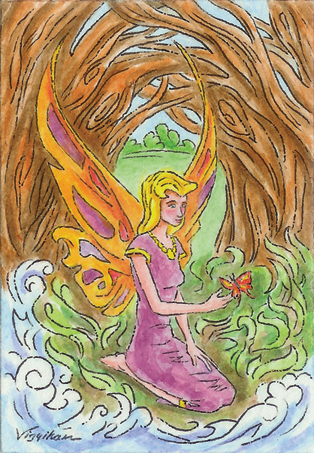The Smallest Painting Ever (well kinda)
Every once in a while the opportunity comes around to set a personal record. Maybe it’s an athletic event – running a best time in a particular race. Or perhaps it’s a musician who’s just performed a difficult piano piece successfully for the first time. These things bring a sense of satisfaction, a knowledge that one has just achieved something unique to him or herself.
Recently, I received a commission to paint a miniature painting. When I say “miniature” I mean like itty bitty. Sure, I know we’ve heard those stories of artists painting complex scenes on heads of pins and such. Creating a painting at the size of 3″ x 2″ isn’t going to set any world records, but for me this is the smallest painting I can recall ever having done! The concept behind the diminutive dimensions of this little piece is that one inch represents one foot in a miniature world. “A miniature world?” As it turns out, there’s an entire population out there of avid miniature enthusiasts visit here. The term “doll house” may be more familiar to many of us, but that term doesn’t really do justice to the exquisite craftsmanship, accuracy, and detailing which go into many of the two and three dimensional pieces of art and craft work which adorn these miniature scale model homes. There’s a whole field of artists and craftsmen who specialize in creating miniature work, as well as large conventions to accommodate their wares and collectors from far and wide.

“Fairy’s Glen” painting by Dean Vigyikan
The person commissioning this painting wanted something in the style of a particular album cover I’d done, featuring playful outlines and loose, watercolor-style coloration. Subject matter was to be fantasy, and so we decided on a fairy as the focal point of the piece. This was also in keeping with the album cover art which was likewise figurative in subject.
Preparing to paint Fairy’s Glen, I knew I’d be challenged by the small scale at which I’d be working. Prior to this, the smallest paintings I’d done were my series of ACEO fantasy paintings at 2.5″ x 3.5.” Doesn’t seem like much of a jump from those dimensions to this new, slightly smaller image – not until actually working on it, that is! In addition to facing the missing board space I’d been used to having at my disposal, I also designed this artwork with considerable detail in mind, so it became a matter of packing more line work into a smaller area.
The creative process began with laying in the line composition on my computer using Adobe Illustrator and then experimenting with color in Photoshop. This allowed me to carefully design the placement of each element and detail, making adjustments with ease until I was satisfied with the direction it was going. Then I printed out the tiny artwork and used a pencil and light-box to trace the lines and transfer them onto my illustration board. That’s where the fun…and challenge…really kicked in. Even my “extra super fine” inking pen seemed like an oversized brush sometimes working in this small space. Nevertheless, I was happy with the overall smoothness of the process. Painting in the color, I used acrylics with a watercolor wash technique, trying to maintain a sense of transparency. This wasn’t one of those paintings that could just “work itself out” and become whatever it became stylistically in the end, since my client and I had a goal of replicating the feel of a particular piece that preceded this one. After the image was completed, I coated it with a clear isolation layer and applied glossy varnish, giving it a luminosity which I found very pleasing.
The album cover for The Itinerant Lady is indeed different from this newer work in some respects, containing less detail and no surrounding landscape to speak of. Click here for a look at the album art. Also the colors and mood of Fairy’s Glen are brighter, as if at the height of day. So this process of letting one work of art inform another can be taken as literally or as loosely as a given project requires. In this case, the original digital album art set the stylistic parameters for an equally fanciful scene, while the newer work, using traditional media, conveys a somewhat different mood, while maintaining a similar narrative sensibility of human and animal interaction.
